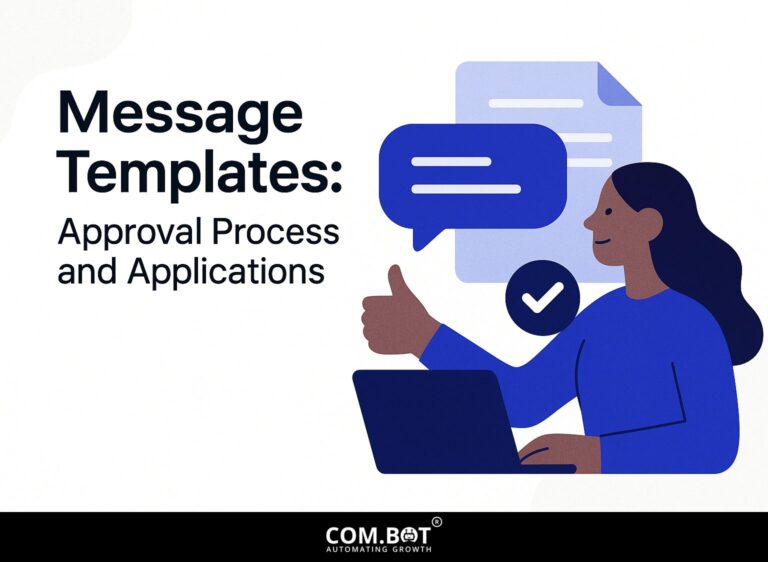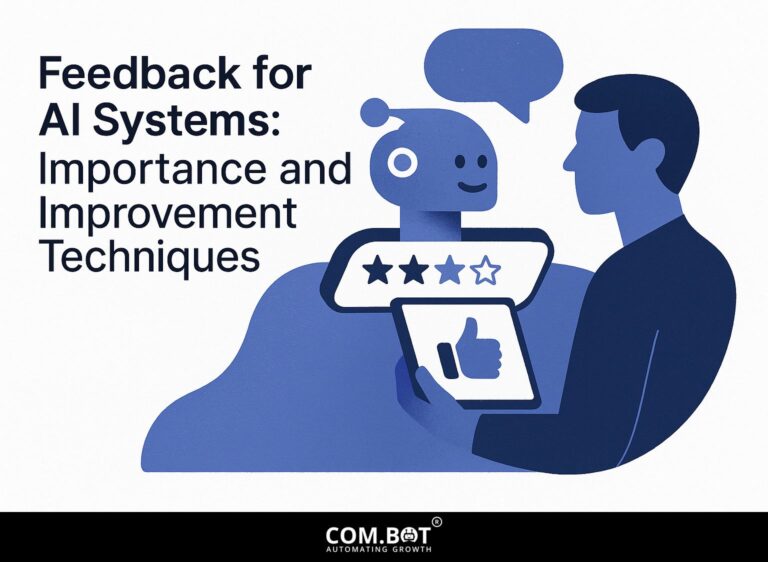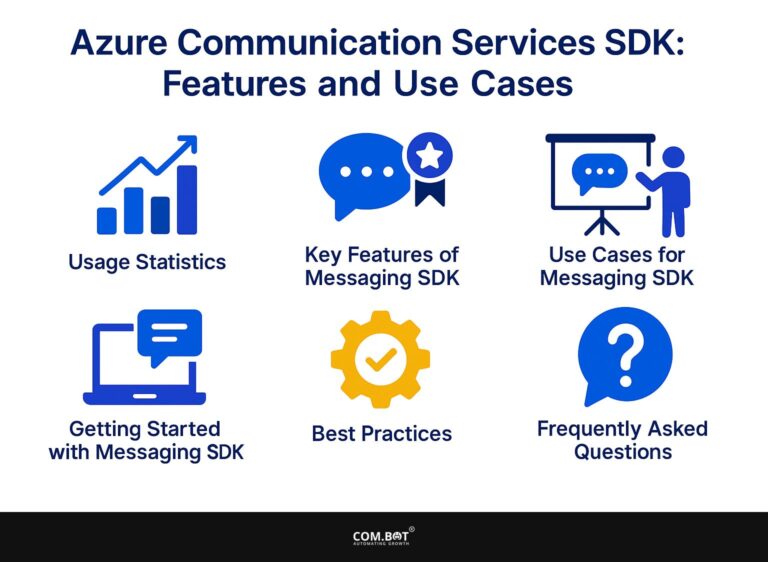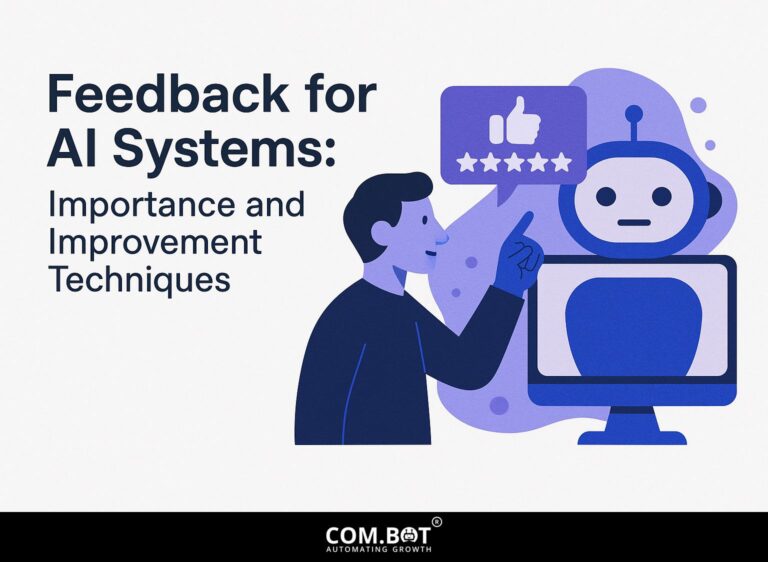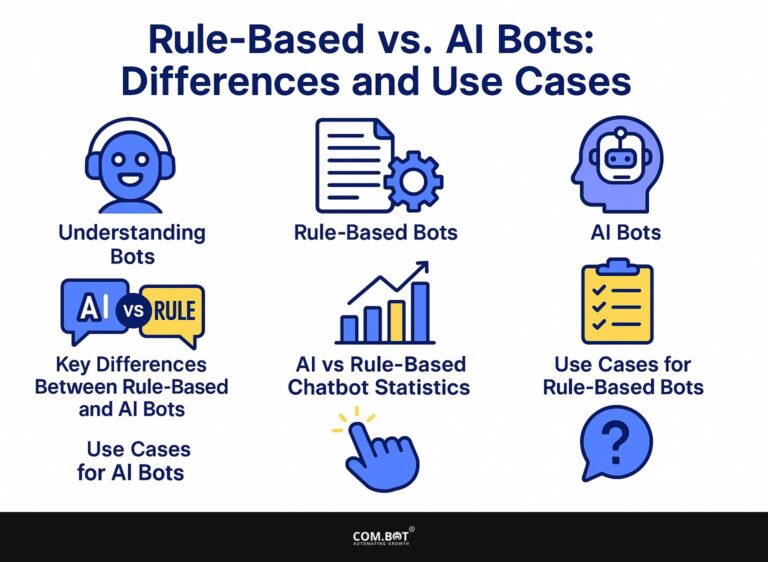Feedback for AI Systems: Importance and Improvement Techniques
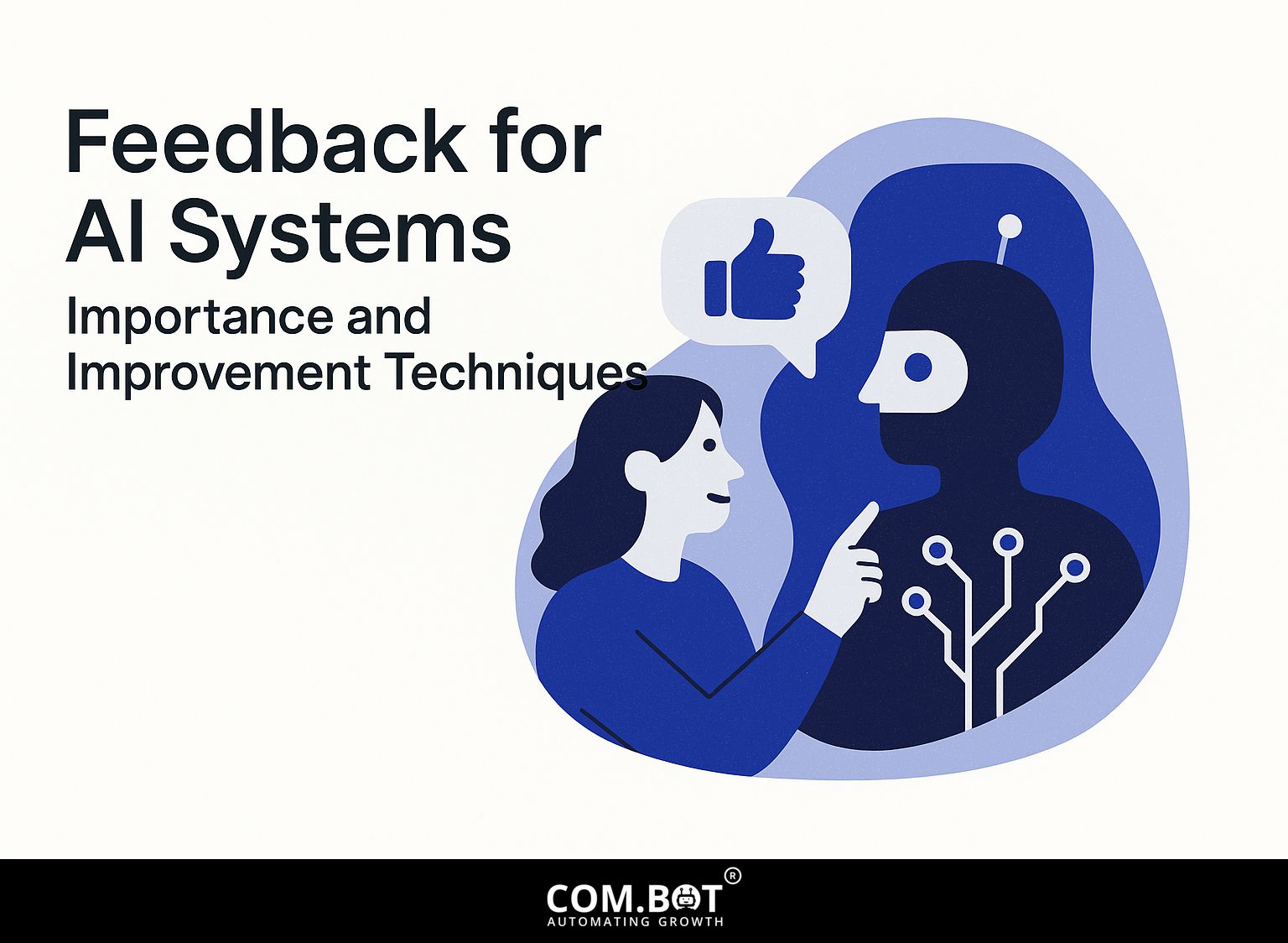
In the fast-changing field of AI, useful human feedback is important for improving machine learning systems. When AI systems use Reinforcement Learning with Human Feedback (RLHF), they can improve how they work and meet user needs more effectively. This article looks at the importance of feedback in artificial intelligence, ways to collect information, and new methods for making improvements. Learn how to use human feedback to create better AI results that build user trust and happiness.
Key Takeaways:
- 1 AI Feedback Mechanisms Statistics
- 2 Importance of Feedback for AI Systems
- 3 Types of Feedback in AI Systems
- 4 Techniques for Gathering Feedback
- 5 Improvement Techniques Based on Feedback
- 6 Challenges in Implementing Feedback Loops
- 7 Frequently Asked Questions
- 7.1 What is the importance of feedback for AI systems?
- 7.2 How does feedback improve AI systems?
- 7.3 What are some techniques for providing feedback to AI systems?
- 7.4 Why should feedback be regularly included in AI systems?
- 7.5 Can AI systems receive automatic feedback?
- 7.6 What are the potential consequences of not incorporating feedback into AI systems?
Definition and Significance
Feedback in AI is the information used to make an AI system more accurate and useful, which is important for its performance.
For example, Amazon uses customer reviews to improve product recommendations and adjust its algorithms. Each review gives important information, helping the system understand which features users find important. This method, which uses data, helps Amazon make better decisions about its inventory and advertising strategies.
Businesses can use the same methods by regularly gathering feedback from users through surveys or data from interactions. Tools such as SurveyMonkey for surveys and Google Analytics for tracking user behavior are important for collecting feedback. They contribute to continuous updates of AI models.
Overview of AI Feedback Mechanisms
AI systems use different feedback methods, like supervised learning and reinforcement learning, to change and improve based on what users do.
Supervised learning involves training models on labeled datasets, where input data pairs with known outputs. For example, an image classification model is trained on sets of images already tagged with their corresponding labels.
In contrast, reinforcement learning employs a reward-based system where the AI learns through trial and error; an example includes training a game-playing AI that receives rewards for winning moves.
These methods make AI models better at recognizing and reacting to human actions. To deepen your understanding of these feedback techniques, our comprehensive guide on the importance and improvement techniques of AI feedback systems can provide valuable insights.
AI Feedback Mechanisms Statistics
AI Feedback Mechanisms Statistics
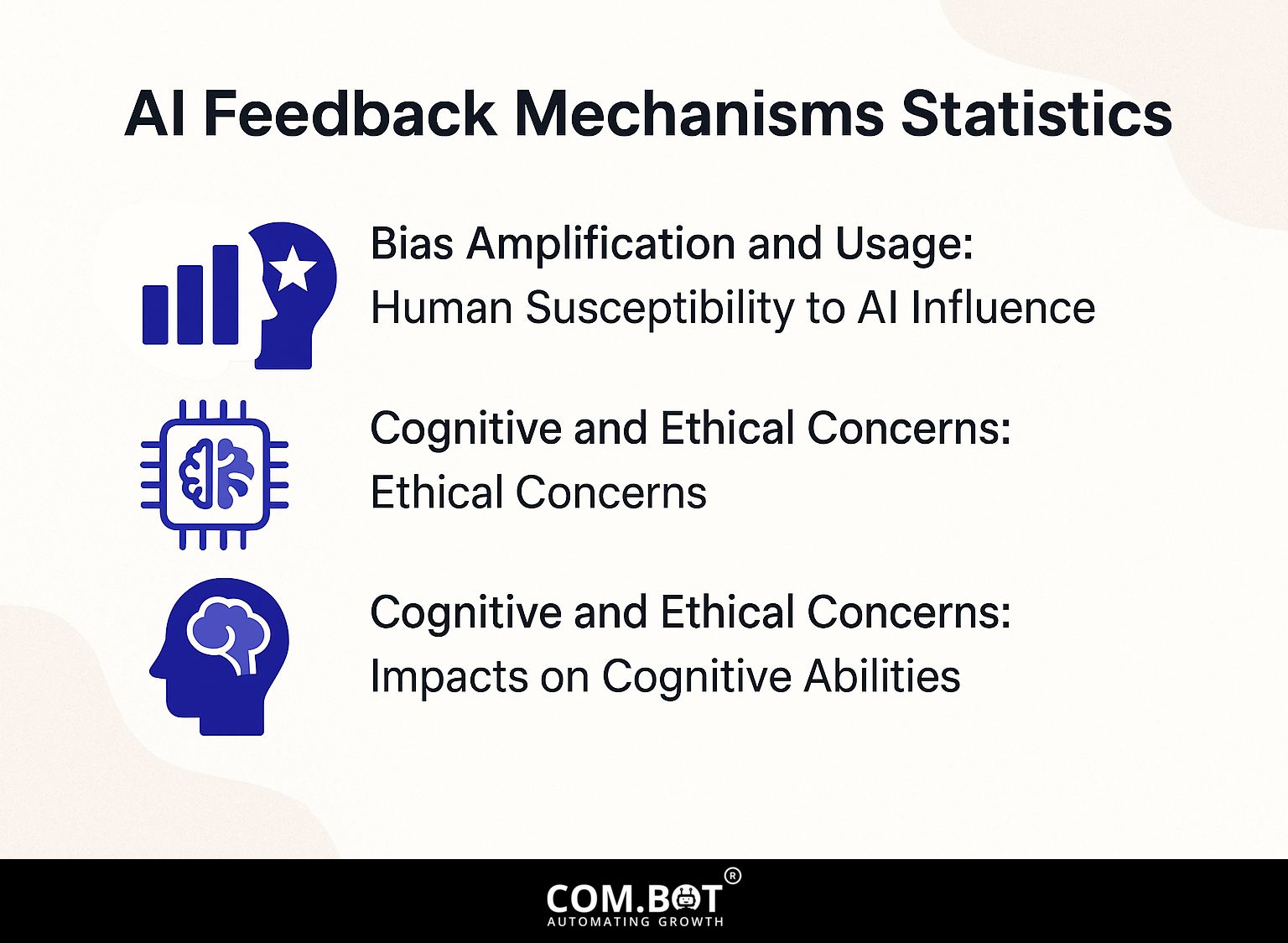
Bias Amplification and Usage: Human Susceptibility to AI Influence
Cognitive and Ethical Concerns: Ethical Concerns
Cognitive and Ethical Concerns: Impacts on Cognitive Abilities
The AI Feedback Mechanisms Statistics show a complete view of how artificial intelligence impacts human choices and moral concerns This dataset shows how AI systems affect human thinking and moral decisions, stressing the need for careful use and supervision.
Bias Amplification and Usage metrics reveal significant human susceptibility to AI influence. Specifically, there is a 15% change in human judgment due to AI bias, suggesting that AI systems can subtly alter human perceptions and decisions. Also, when people see AI answers that don’t match their first thoughts, they often rethink their choices. 32.7% of the time. These statistics highlight how AI influences human thinking, stressing the need for clear communication and reducing bias when creating AI systems.
- Cognitive and Ethical Concerns: Ethical concerns surrounding AI are highlighted by the 68% impact of AI hallucinations, where AI systems generate false or misleading information, potentially leading to significant ethical dilemmas. Additionally, algorithmic bias is observed in 85% of cases, raising serious concerns about fairness and discrimination in AI-driven processes.
- Impacts on Cognitive Abilities: AI’s influence on cognitive skills is marked by a 27.7% decrease in ability to make decisions, illustrating how reliance on AI can impair human judgment. Furthermore, a substantial 75% decline in critical thinking skills The use of AI highlights the importance of balancing AI tools with developing individual thinking abilities.
The AI Feedback Mechanisms Statistics demonstrate the dual nature of AI’s impact on society. While AI offers efficiency and innovation, it also poses challenges related to bias, ethical considerations, and cognitive dependency. To tackle these problems, we need a broad method that focuses on ethical AI development, increases transparency, and encourages education on critical thinking to reduce possible negative effects. By doing this, society can make the most of AI’s advantages while protecting human thinking and moral values.
Importance of Feedback for AI Systems
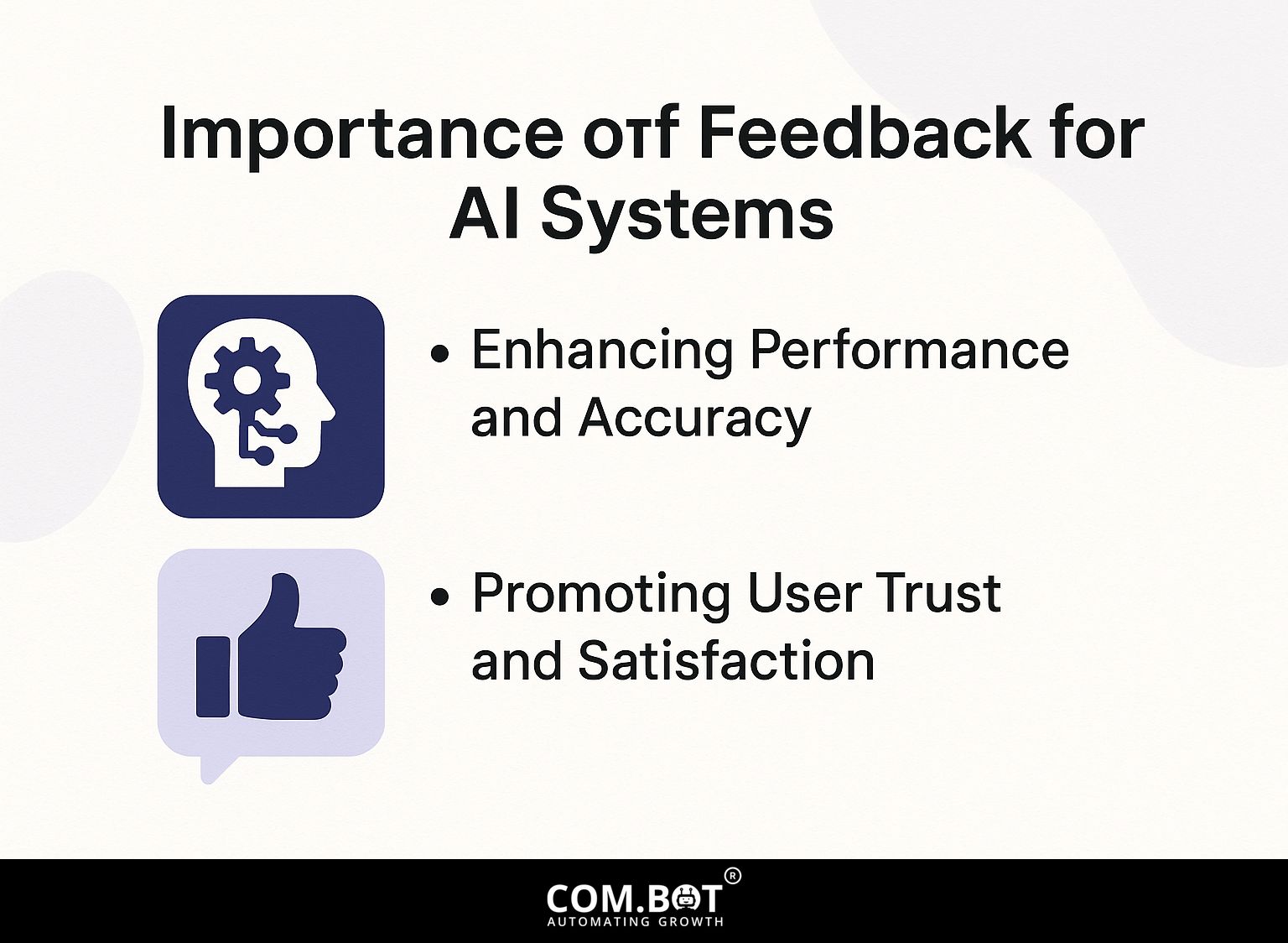
Feedback is important for AI systems because it greatly affects how well they work and helps users trust the technology.
Enhancing Performance and Accuracy
AI systems that use user feedback can increase their accuracy by up to 30%, showing a clear connection between feedback and accuracy.
To make the most of this potential, organizations should set up regular feedback systems. Send surveys right after users finish their interactions to get immediate feedback on their experience.
For instance, using tools like SurveyMonkey or Typeform can help gather specific metrics related to usability and satisfaction. Analyze the data weekly to identify recurring issues, then prioritize updates based on user pain points.
This step-by-step method will improve accuracy and increase user satisfaction, which will lead to higher retention rates.
Promoting User Trust and Satisfaction
Building trust is important. AI systems that change with user feedback often result in more satisfied users, increasing user retention by 40%.
For example, GitHub implemented a feedback loop by allowing users to submit feature requests and report bugs directly through their platform.
By reviewing this feedback, they made improvements such as easier project management tools and better collaboration features. This quick response increased user satisfaction and made users feel part of a community.
Businesses wanting to improve their platforms should gather feedback regularly through surveys or user testing sessions, so their products change according to what users need.
Types of Feedback in AI Systems
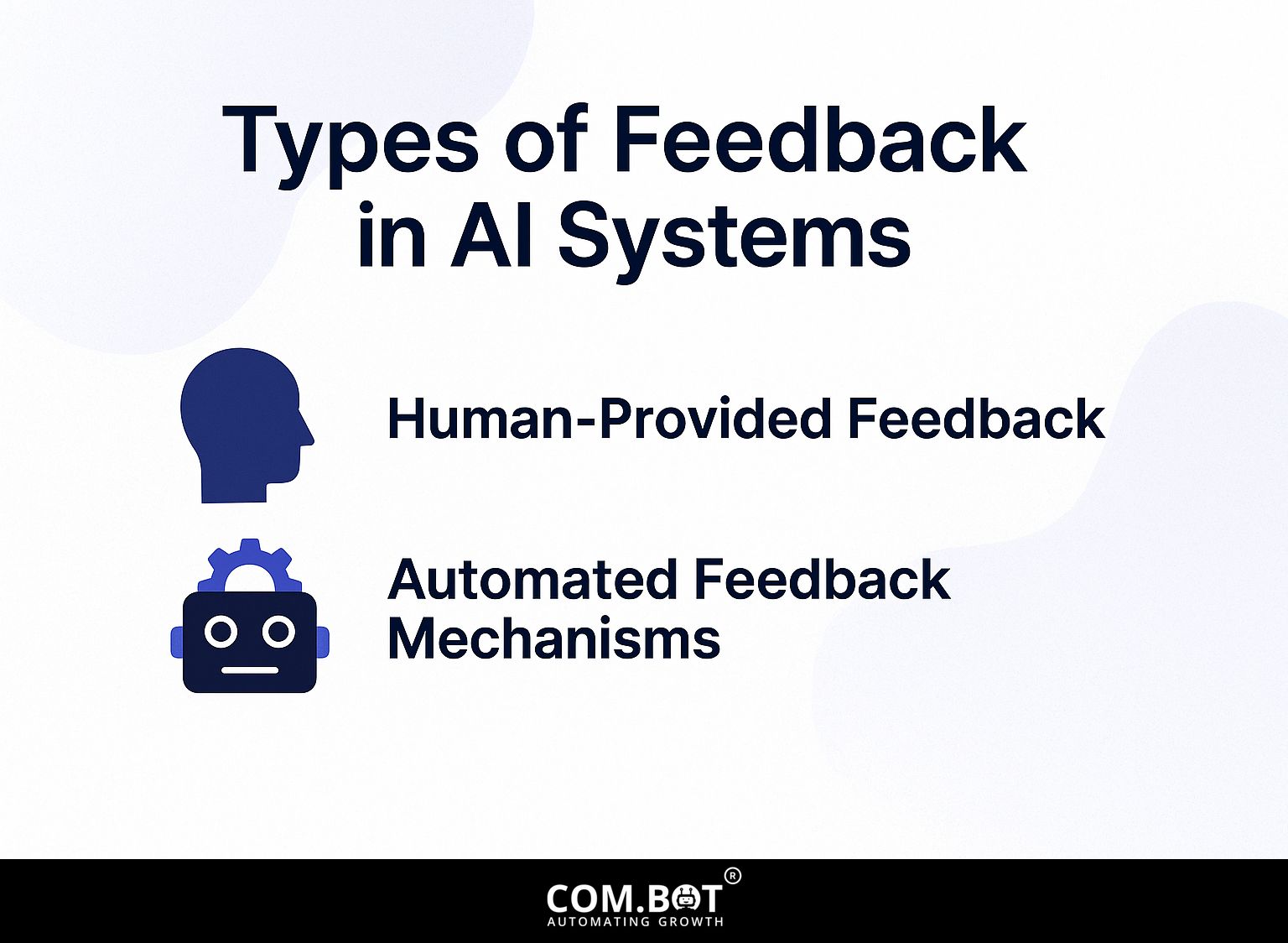
AI systems use different kinds of feedback, such as input from people and machine-based methods, to reach the best learning results. For an extensive analysis of these methods, our comprehensive study on feedback improvement techniques examines how these systems can be optimized.
Human-Provided Feedback
Feedback from people, like ratings and reviews, is important for improving the accuracy of AI models.
To effectively collect and apply human feedback in AI training, tools like Label Studio can be highly beneficial. Label Studio lets you gather user inputs through surveys or interactive tools to annotate data. This helps your AI models learn from different viewpoints.
Adding feedback systems where users can regularly rate AI results helps improve the model’s predictions over time. For instance, implementing a user feedback system in a chatbot application can lead to significant improvements in response accuracy, as real-time adjustments are made based on user experiences.
Automated Feedback Mechanisms
Systems that automatically check feedback, like those that track performance, regularly evaluate AI results to help make changes quickly.
For example, tools like Google Analytics monitor user actions and show you how people interact with your content.
By analyzing bounce rates, session duration, and click-through rates, you can adjust your strategies accordingly.
To implement this, start by setting up Google Analytics on your website. Regularly review the reports, focusing on metrics that highlight user behavior.
Adjust your content plan using this data-if a topic is popular, consider creating more content about it to maintain your audience’s interest.
Techniques for Gathering Feedback
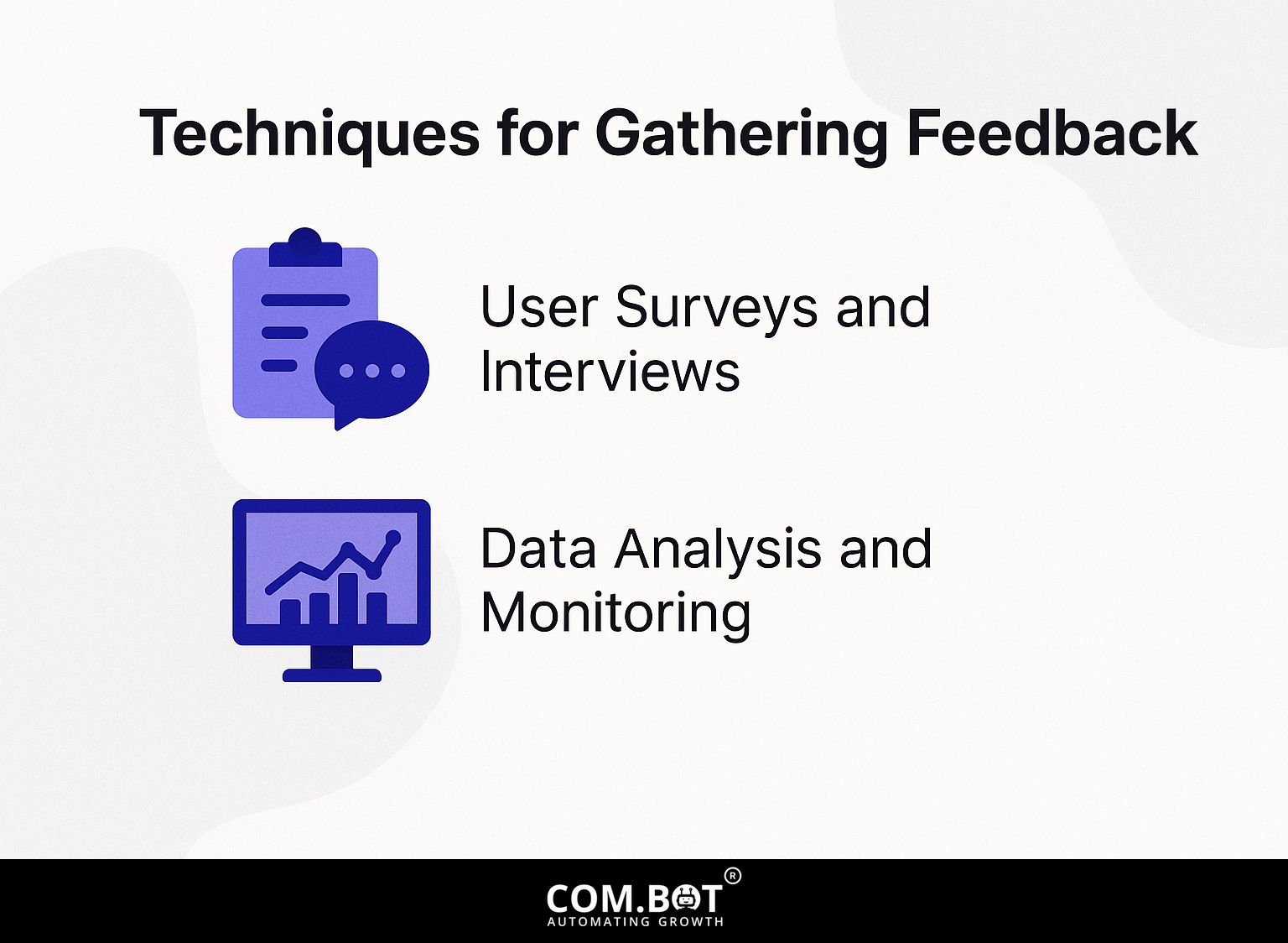
Effective feedback gathering uses different methods, like user surveys and data analysis, to understand how well the AI is performing.
User Surveys and Interviews
User surveys provide clear feedback. A well-structured survey increases response rates by 50%, providing helpful information for refining AI.
To design effective user surveys, start by defining clear objectives. Use tools like SurveyMonkey or Google Forms for easy distribution and analysis.
Write clear questions using both multiple-choice and open-ended types to gather both numbers and detailed information.
To get better response rates, give incentives like discounts or special content, make sure it’s easy to use on phones, and remind those who haven’t replied. Limit surveys to a few minutes of completion time to respect users’ attention spans.
By following these steps, you’ll collect useful information that leads to important improvements in AI.
Data Analysis and Monitoring
Regular data analysis, facilitated by tools like Tableau or Google Data Studio, enables the identification of trends and anomalies in AI performance metrics.
By analyzing data from user interactions like click rates, engagement levels, and error reports, analysts can understand how well the AI is working.
For example, using Google Analytics to monitor how users interact with your app helps show which features are the most popular. To further enhance AI system effectiveness, examining the importance of feedback and improvement techniques can be crucial.
A/B testing different AI algorithms can reveal which variations lead to improved user satisfaction. Regularly checking these metrics helps make timely changes to improve user experience and service quality.
Improvement Techniques Based on Feedback
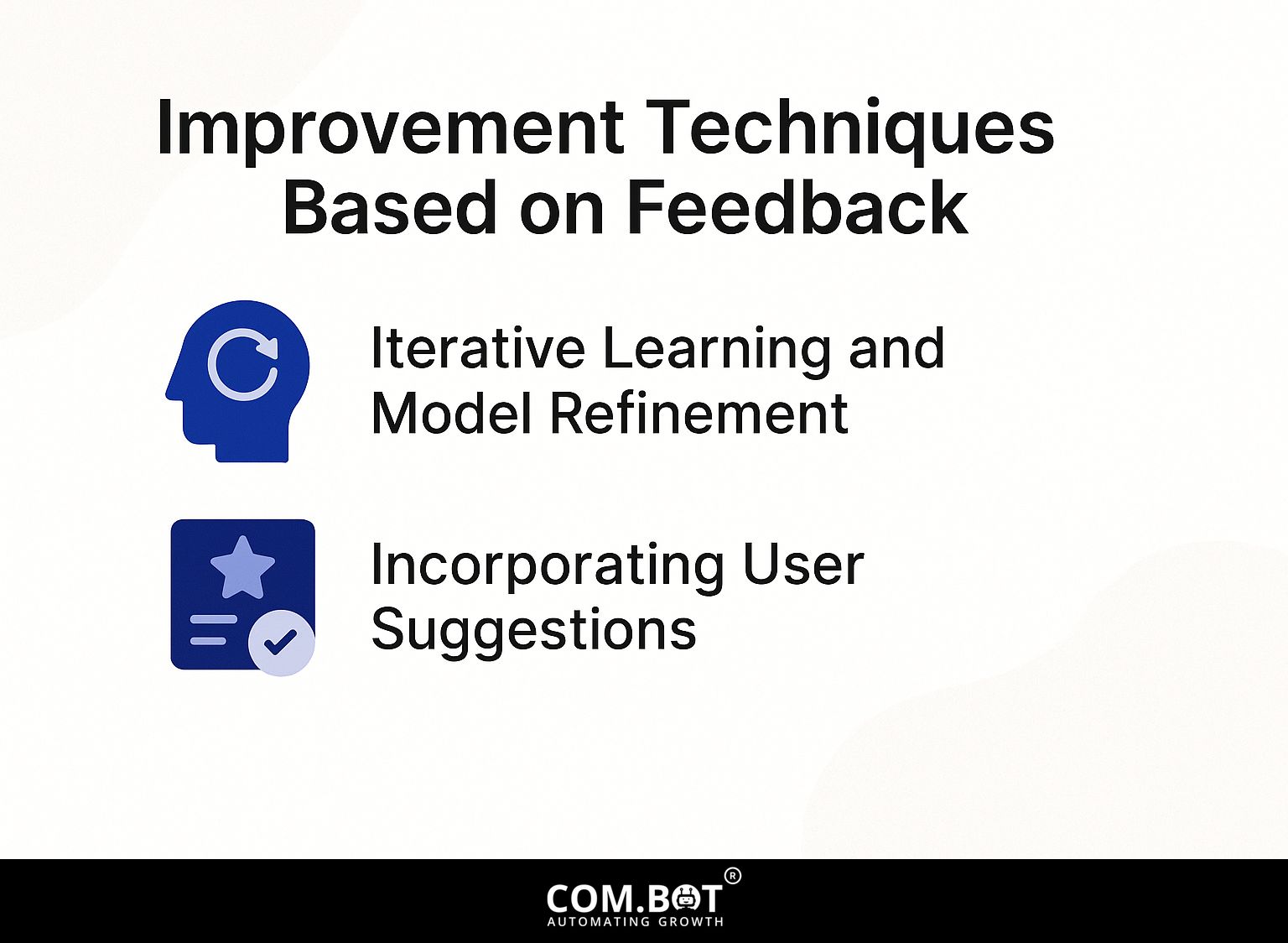
Using feedback to keep improving means regularly learning and fine-tuning models to make sure AI systems stay up-to-date and useful. One of our most insightful case studies delves into how feedback mechanisms can dramatically enhance AI performance and adaptability.
Iterative Learning and Model Refinement
Applying repeated learning methods with feedback from users can improve AI algorithm performance by 20-30%.
Companies such as Google and IBM regularly improve their AI models by repeatedly learning from user activities that are added to their training data.
For example, Google uses data from what people are doing now to change its search algorithms, making search results more accurate.
IBM’s Watson examines user questions and results to change its answers, which improves accuracy in instant data analysis.
By regularly gathering feedback, these organizations make sure their AI stays responsive and matches user needs, leading to better performance over time.
Incorporating User Suggestions
Using user suggestions can greatly improve AI systems. Companies have seen up to 40% more engagement by changing features based on user feedback.
To effectively integrate user feedback, establish a continuous feedback loop within your development cycle.
- Start by regularly asking users for feedback on their experiences through surveys or polls. For instance, Spotify uses in-app surveys to learn about user preferences, which informs their algorithm tuning.
- Implement a user-friendly interface for submitting suggestions directly within your app. Duolingo lets users send in ideas for new features, encouraging people to connect and participate.
- Frequently check this data while working on development sprints to make sure user feedback influences your changes, resulting in better satisfaction and retention.
Challenges in Implementing Feedback Loops
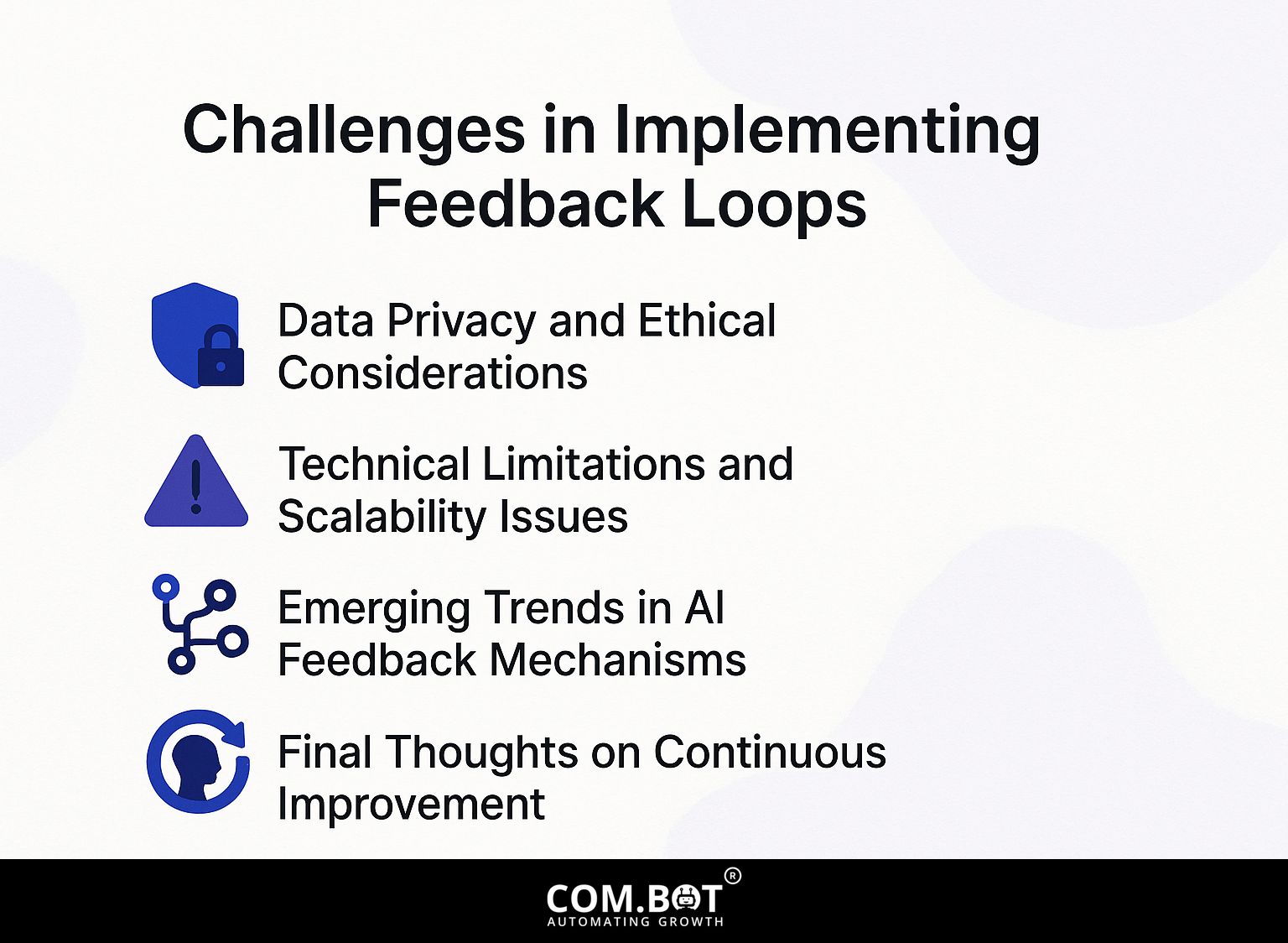
Setting up useful feedback systems involves specific challenges, particularly regarding the privacy and ethical issues related to user data.
Data Privacy and Ethical Considerations
Knowing data privacy rules, such as GDPR, is essential for AI systems. Ignoring these rules can result in fines reaching up to EUR20 million or 4% of global income.
To follow the rules when gathering user data for feedback, organizations should stick to a few effective methods.
- First, always obtain explicit consent by providing clear information on data usage.
- Use tools like PrivacyPolicies.com to create compliant policies with ease.
- Create feedback forms with optional checkboxes to make things clearer.
- Regular checks of data practices help spot possible risks and confirm that regulations are being followed as they change.
- Keep users informed about their rights, allowing them to access or delete their data upon request.
Technical Limitations and Scalability Issues
Technical limitations can hinder the scalability of feedback loops, with performance degradation reported in systems handling over 10,000 simultaneous feedback inputs.
To address these barriers, consider implementing distributed systems and load balancing. For example, using tools like Apache Kafka can help handle large amounts of data quickly.
By using microservices architecture, each part of your feedback system can grow independently, keeping everything running smoothly even with lots of users. Regularly monitoring system performance with solutions such as Grafana can also preemptively identify bottlenecks, allowing for timely optimization.
These strategies help keep operations running smoothly and make feedback systems more reliable.
Emerging Trends in AI Feedback Mechanisms
Recent changes show that predictive analytics and tools providing immediate responses will significantly shape upcoming AI feedback systems.
Technologies like machine learning algorithms are expected to improve user experience by tailoring recommendations to individual preferences. For example, tools like Google Analytics provide real-time data, enabling businesses to quickly change their strategies.
In the same way, platforms like Hotjar offer heatmaps and session recordings, helping to better grasp how users interact.
In the coming years, combining AI with customer feedback tools will probably lead to quick changes in products based on what users say, resulting in more responsive and customized services in many different fields. This evolution can be better understood through expert opinions on key techniques for improving AI feedback systems.
Final Thoughts on Continuous Improvement
Building effective AI is an ongoing process, requiring strong feedback systems and cooperation with users for lasting progress.
To encourage teamwork, developers should use tools like UserVoice or Google Forms to collect feedback on user experience.
Regular surveys can pinpoint issues and suggestions, while platforms like GitHub allow for transparent feature requests.
Establishing a community forum encourages ongoing dialogue. Successful AI projects often use Discord channels to get immediate feedback and build a connection with users.
By focusing on these methods, AI developers can quickly respond to what users need, resulting in more useful and successful solutions.
Frequently Asked Questions
What is the importance of feedback for AI systems?
Feedback is important for AI systems because it helps them keep learning and getting better. Without feedback, AI systems couldn’t change to make correct predictions and choices based on new information.
How does feedback improve AI systems?
Feedback helps AI systems correct errors and lessen biases, leading to more accurate and reliable results. It also helps find areas that need improvement and enables AI systems to learn from new data and adjust to different situations.
What are some techniques for providing feedback to AI systems?
Some techniques for providing feedback to AI systems include manual labeling of data, human feedback and input, and reinforcement learning algorithms that reward the system for correct predictions and actions.
Why should feedback be regularly included in AI systems?
Regular feedback is essential for the continuous improvement of AI systems. When new information and situations arise, feedback helps the system to change and improve, keeping it useful and efficient.
Can AI systems receive automatic feedback?
Yes, feedback can be automatically processed for AI systems using self-improving algorithms and machine learning methods. This allows for faster responses and more accurate changes.
What are the potential consequences of not incorporating feedback into AI systems?
Not using feedback in AI systems can result in wrong predictions and decisions, along with biases and mistakes that might not be noticed. This can have serious consequences, especially in high-stakes applications such as healthcare or finance.
